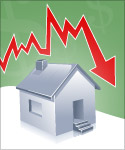 One of the most exciting things about being a real estate investor is knowing what markets will produce the greatest long-term returns – especially while in the middle of a challenging housing market.
One of the most exciting things about being a real estate investor is knowing what markets will produce the greatest long-term returns – especially while in the middle of a challenging housing market.
In a down market, savvy real estate investors are eager to find out how they can best leverage their resources. And expert forecasts are some of the best tools they can use to back up their strategies. A good example comes from real estate consulting firm John Burns Real Estate (JBRE), which has recently predicted that homeownership will fall from 70.0 percent to 62.1 percent by 2015 due to a weak economy, weak consumer confidence, limited mortgage availability, higher rates of foreclosures and short sales, and other factors.
The JBRE forecast, although based on broad market conditions, points out that we are going to see an increasing number of renters and therefore a greater demand and need for rental housing.
Savvy real estate investors choose investment properties that are located in markets with the greatest long-term growth potential. This allows them to invest wisely today while hedging their bets on the future growth and appreciation of their chosen markets.
Our 2012 Housing Market Forecast lists the Top 100 Metropolitan Markets based on future job growth and projected price appreciation. If you are interested in finding growth markets with strong appreciation potential, then the McAllen-Edinburgh-Mission, Texas metropolitan area may be your first choice. We project its 10-year future job growth to surge by 32.3 percent and home values to appreciate by 37.9 percent in five years. In addition, property values remain relatively affordable with the median sales price around $100,000.
Aside from this Texas residential investment area, our report reveals other real estate markets with great potential including two from Colorado (Colorado Springs and Denver-Aurora), as well as California (Sacramento-Arden-Arcade-Roseville, and Oxnard-Thousand Oaks-Ventura). Other markets that made the Top 10 include North Port-Bradenton-Sarasota, FL; Las-Vegas-Paradise, NV; Hartford, CT; Springfield, MA; and Phoenix-Mesa-Glendale, AZ. These areas have a five-year appreciation forecast well above 21 percent.
And what does this mean for real estate investors? There’s a goldmine out there waiting for you to take full advantage of! A fall in homeownership means a rise in rental units to accommodate the surge in demand from those who have recently lost their homes to foreclosure, those who cannot afford to buy property, and those who are still saving up for a new home. Last October 2011, the National Association of Realtors (NAR) reported that the number of rental homes had gone up to 38 million units in 2Q11 and the vacancy rate of single-family homes and multifamily units was at an all-time low rate of 9.2 percent.
Investors never think twice about snapping up bargain properties with positive cash flow. As NAR chief economist, Lawrence Yun , puts it, “The dynamics of falling rental vacancy rates mean increased landlord pricing power. Naturally as a result rents have been pushed higher…Rising rents mean a better rate of return for real estate investors.”
Cash flow investment properties are indeed your best hedge against the negative impacts of a down market. Take it from Morgan Stanley’s “Housing 2.0 The New Rental Paradigm” report. The financial services company observes that gross rents are “historically attractive relative to current distressed prices. Adding to this attractiveness is the fact that multifamily data shows rents continuing to rise.” More so, it favors single-family homes as the most ideal form of real estate investment in the market today owing to their huge rental potential.
JBRE’s forecast also reveals that homeownership will not be on an upswing until 2025 at 67.1 percent on the back of foreclosed homes returning to ownership, improved economic conditions and normal mortgage credit, and an increase in the propensity of households to own a home. That may signal the time to consider selling your portfolio and taking a profit, or trading up into more real estate using the IRS 1031 tax deferred exchange.
There are plenty of investment opportunities out there today. Be sure to take action, do your homework and invest wisely. As JBRE puts it, “The American dream of homeownership is still alive and well…”




